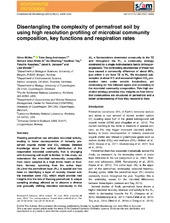| dc.contributor.author | Müller, Oliver | |
| dc.contributor.author | Bang‐Andreasen, Toke | |
| dc.contributor.author | White III, Richard Allen | |
| dc.contributor.author | Elberling, Bo | |
| dc.contributor.author | Taş, Neslihan | |
| dc.contributor.author | Kneafsey, Timothy J. | |
| dc.contributor.author | Jansson, Janet K | |
| dc.contributor.author | Øvreås, Lise | |
| dc.date.accessioned | 2019-06-14T16:25:40Z | |
| dc.date.available | 2019-06-14T16:25:40Z | |
| dc.date.issued | 2018-12-13 | |
| dc.Published | Müller O, Bang‐Andreasen, White III, Elberling B, Taş, Kneafsey TJ, Jansson JK, Øvreås L. Disentangling the complexity of permafrost soil by using high resolution profiling of microbial community composition, key functions and respiration rates. Environmental Microbiology. 2018;20(12):4328-4342 | eng |
| dc.identifier.issn | 1462-2912 | en_US |
| dc.identifier.issn | 1462-2920 | en_US |
| dc.identifier.uri | http://hdl.handle.net/1956/20031 | |
| dc.description.abstract | Thawing permafrost can stimulate microbial activity, leading to faster decomposition of formerly preserved organic matter and CO2 release. Detailed knowledge about the vertical distribution of the responsible microbial community that is changing with increasing soil depth is limited. In this study, we determined the microbial community composition from cores sampled in a high Arctic heath at Svalbard, Norway; spanning from the active layer (AL) into the permafrost layer (PL). A special aim has been on identifying a layer of recently thawed soil, the transition zone (TZ), which might provide new insights into the fate of thawing permafrost. A unique sampling strategy allowed us to observe a diverse and gradually shifting microbial community in the AL, a Bacteroidetes dominated community in the TZ and throughout the PL, a community strongly dominated by a single Actinobacteria family (Intrasporangiaceae). The contrasting abundances of these two taxa caused a community difference of about 60%, just within 3 cm from TZ to PL. We incubated subsamples at about 5°C and measured highest CO2 production rates under aerobic incubations, yet contrasting for five different layers and correlating to the microbial community composition. This high resolution strategy provides new insights on how microbial communities are structured in permafrost and a better understanding of how they respond to thaw. | en_US |
| dc.language.iso | eng | eng |
| dc.publisher | Wiley & Sons Ltd | en_US |
| dc.rights | Attribution CC BY | eng |
| dc.rights.uri | http://creativecommons.org/licenses/by/4.0/ | eng |
| dc.title | Disentangling the complexity of permafrost soil by using high resolution profiling of microbial community composition, key functions and respiration rates | en_US |
| dc.type | Peer reviewed | |
| dc.type | Journal article | |
| dc.date.updated | 2019-01-24T13:06:07Z | |
| dc.description.version | publishedVersion | en_US |
| dc.rights.holder | Copyright 2018 The Authors | en_US |
| dc.identifier.doi | https://doi.org/10.1111/1462-2920.14348 | |
| dc.identifier.cristin | 1664511 | |
| dc.source.journal | Environmental Microbiology | |

